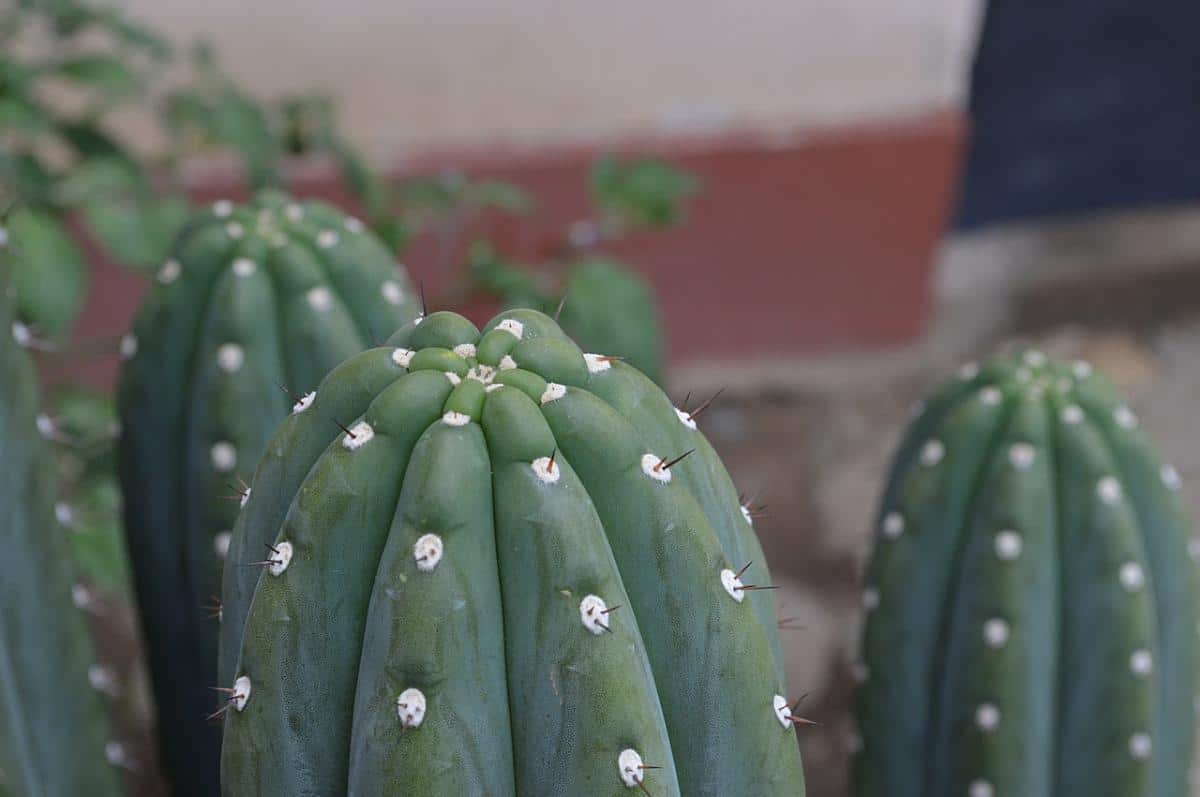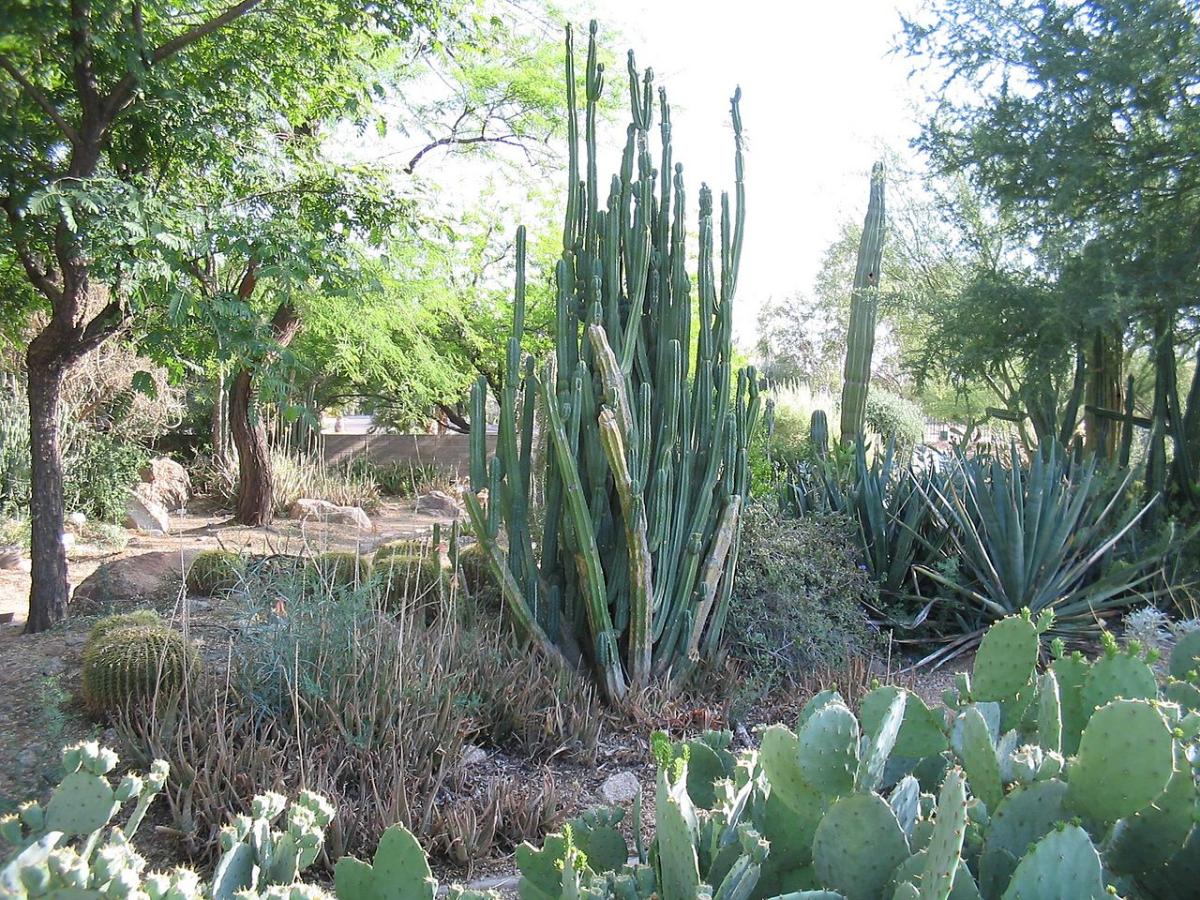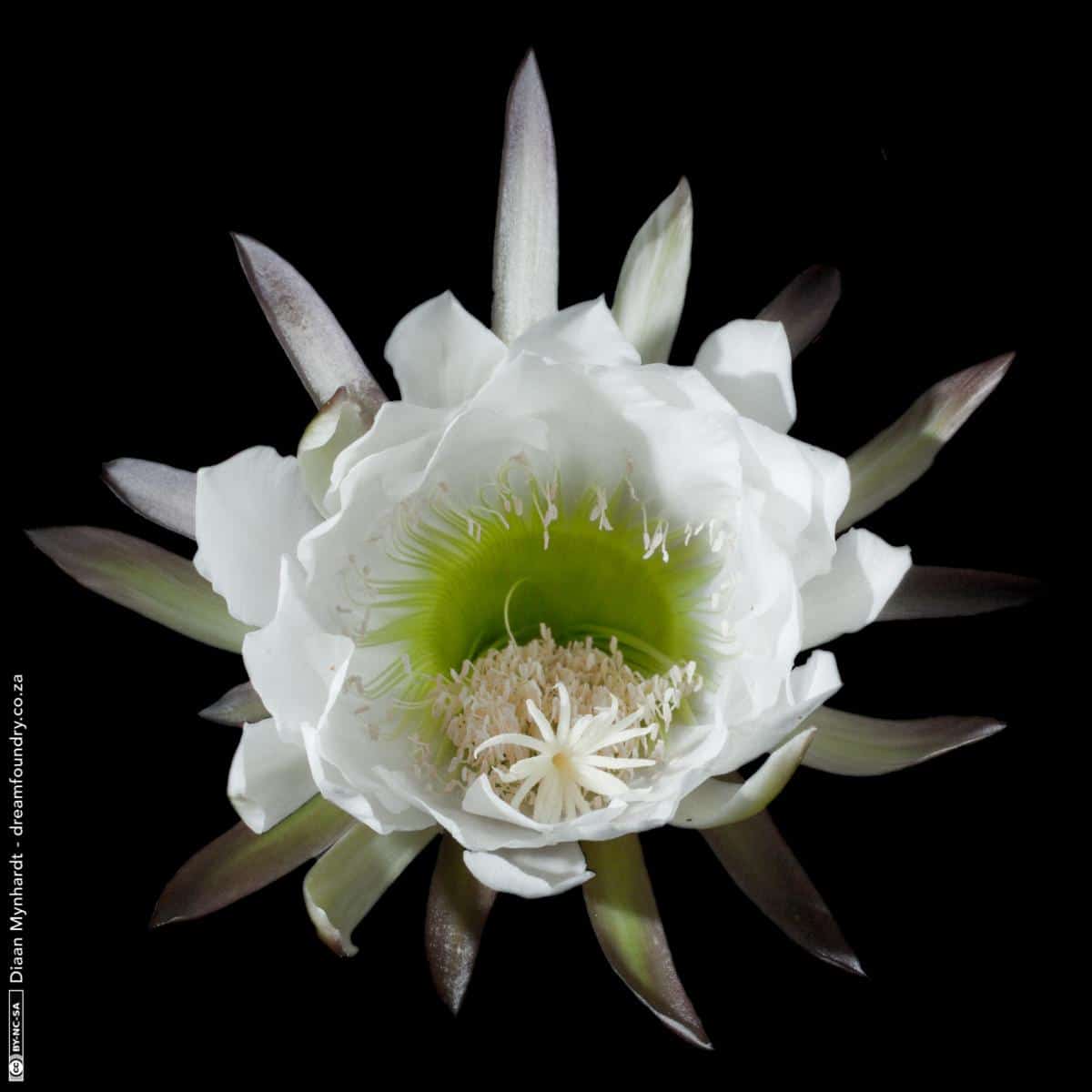
Image - Wikimedia / Cbrescia
El San Pedro cactus it is one of the thorny plants that has the most beautiful flowers. It has a rapid growth rate, being able to measure 4 meters in height. But, despite what it may seem, it can be kept in a pot throughout its life, since its roots are superficial, and its stem is no more than 30 centimeters thick.
It is very easy to care for, but the truth is that sometimes it begins to rot and can end up perishing. Why? What is the secret of the cultivation of the San Pedro Cactus?
Origin and characteristics of the San Pedro Cactus

Our protagonist, known by the scientific name of Echinopsis pachanoi, It is a cactus that is characterized by having a dark green branched stem up to 7 meters high, although the normal thing is that it does not exceed 4m. It is thorny, to the point that its spines can measure up to 2 centimeters, especially in youth. The flowers appear only at night, closing in the morning, and measure up to 23 centimeters of length; they are lightly scented.
It is native to the South of Ecuador and North of Peru. This is important to know when we decide to buy a copy. The San Pedro does not support frost, only light ones (up to -3ºC) and as long as they are of short duration. Ideally, the temperature should always be above 3ºC, otherwise it could have problems growing well.
What are the care that must be given?
The San Pedro Cactus is a plant that does not require much care or attention, but to prevent it from rotting it is very important that a suitable substrate is chosen and that it be watered only when it is necessary to do so. So let's see how you can grow healthy for years to come:
Irrigation and land
It should not be watered excessively. In summer we will give it a weekly watering, and the rest of the year every 20 days; and in winter you hardly have to water it (a monthly watering will be enough). But it is not enough to water it very occasionally, but also it is necessary to plant it in substrates or lands that have very good drainage, such as black peat mixed with perlite (or any other similar material) in equal parts.
Location
Like all cacti, it is very important to place it in an area where it gets direct sunlight. If it is indoors, it is highly advisable to put it in a room where a lot of natural light enters.
Transplant

Image - Wikimedia / Diaan Mynhardt
Regarding the transplant, if it is potted, it will be done once every two years, in spring. In this way you can continue to grow and develop properly.
The steps are as follows:
- The first thing to do is choose a pot with holes that is about 5-6 centimeters larger than the one you have. The material with which it is made is indifferent, but you should know that if it is made of clay, the plant will root better because its roots will have a place to hold.
- Then it is filled to a little less than half with light substrates, which drain water quickly. For example, peat with perlite can be used in equal parts, or pumice (for sale here) with 30% peat.
- The cactus is then removed from the 'old' pot. If necessary, a few strokes will be given to the sides of the pot to make the plant come out better.
- It is then introduced into the new pot, placing it in the center. In the event that it is too high, earth will be removed; and if, on the contrary, it is too low, it will be dropped.
- Finally, the pot is filled with substrate, and the cactus is placed in an area with light.
After a week it will be time to resume watering. It is advisable not to do it immediately after transplanting to give the roots time to recover.
Plagues and diseases
The San Pedro Cactus is quite hardy in general. But there are certain pests that can do you a lot of harm:
- Mealybugs: they can be the cottony ones or those that are limpet type. You will see them between rib and rib especially, feeding on the sap of the plant. They are removed with diatomaceous earth (for sale here), or cleaning the cactus with mild soap and water.
- Snails and slugs: these animals devour the spineless parts of the cactus, unless measures are taken such as spreading molluscicides around (be very careful with using this product if you have pets and / or children), or protecting the plants with mosquito netting for example.
If we focus on diseases appear when the plant has been watered too much and / or a compact substrate or soil is combined with high humidity. Therefore, it is necessary to water when the soil is dry, but it is also important that the soil is light and drains the water quickly.
When you see that the plant is becoming soft, or if it already has whitish or gray spots, you have to remove it from the pot, dry its roots with absorbent paper, and then plant it in a new pot with better quality substrate.
Multiplication

Image - Wikimedia / alexik
El Echinopsis pachanoi multiplies by seeds and stem cuttings in spring and summer.
- Seeds: you have to sow them in trays, or if you prefer in pots, with quality cactus soil (for sale here), or with a mixture of peat and perlite in equal parts. Moisten the soil well, and then spread the seeds on the surface. You can cover them if you want with a little substrate, but afterwards, leave the hotbed in a bright area. If all goes well, they will germinate in about 10-15 days.
- Cuttings: to multiply it by cuttings you have to cut a piece and leave it in a cool and dry place for about 7 days. This will dry the wound. After that time, you have to plant it in a pot in the sun or in semi-shade with a substrate such as the pumice, and water. After about two weeks it will begin to produce roots.
What uses does it have?
The use that is currently allowed for individuals is ornamental. It is a plant that grows slowly, but it looks very good in a pot, let alone in a cactus garden or in a rockery, where it can have an optimal development.
But in their places of origin, Native Americans used it for its psychedelic properties, as it contains a high concentration of mescaline, a hallucinogenic alkaloid.
Where to buy Cactus San Pedro?
If you are interested in having one, you can buy your plant by clicking here:
I hope that with these tips you can have your San Pedro Cactus for many years.

Hello Monica. Looking for information about the diseases of San Pedro, I came to your blog, which by the way has concrete, useful information and also beautiful photos. I want to consult you about a Saint Peter that I have had for about 5 years, the son of another Saint Peter who is also mine; It had been growing very healthy, today it is about 50 cm tall and until a few days ago it was all even green, very beautiful. It turns out that about 10 days ago he had grayish spots with some black dots in their center, and they are spreading along the cactus. I don't know what it will be, nor what I can do. For 5 years it has had a lot of sun all day, and it is on the usual plateau, the irrigation is the same as always, and in my country it is mid-summer, very hot. I appreciate what you can advise me on what I can do to help him. A hug. Florence
Hello Florence.
I recommend you move it to a larger pot. Cacti need a transplant every 1-2 years in order to continue growing healthy.
You must also pay it with a liquid cactus fertilizer following the instructions specified on the package from spring to late summer.
A greeting.
The San Pedro plant is very beautiful, I have one in my little garden in a pot, in 17 years it has grown in such a way that it measures 2.60 meters. It weighs about 90 kilos, it has seven arms, the most curious thing that has happened is that the largest arm broke due to the action of the wind, since I found it lying on the floor, I was sorry for what happened and I placed it in a bucket with water, result: it grew roots and the strangest thing is that from this part of San Pedro, two beautiful flowers sprouted, white and giving off a delicious aroma, the bad thing is that I had to wait so many years to see it bloom and the flowers they only last 12 hours.
Hello Monica,
I found your blog looking for instructions on how to transplant a San Pedro shoot. I have a mother plant (it is a trunk about 10-12 cm high) from which a sprout came out two years ago. The young shoot is already almost 40 cm tall, and I have been suggested that I detach it from the mother and plant it in its own pot, and I have two questions about it:
1) The young shoot has started to grow again (it is spring here in the southern hemisphere), you can see it at the tip where it has a lighter green color. Can I detach it from the mother even though she is growing?
2) If this is the moment to detach it and plant it, how many centimeters should be left under the ground? (I know that beforehand I must let it heal for about 7-10 days, looking dry and shaded).
I hope you can guide me. Many greetings.
Claudio
Hello Claudio.
Yes, that sprout can be separated from the mother plant in spring-summer, let the wound dry and plant it in another pot, without problems 🙂
A greeting.
Good morning, excellent article. I want to move my San Pedro from a pot to a large planter that I have bought and my question is what kind of compatible plants could go with it. logic tells me that my Kalanchoe and jade ... but what does the expert tell me? Same doubt with a virgin vine, that the pot looks very empty (maybe some daisies?) But of course, I already skip the topic of the article to the bullfighter. Thanks in advance! Long live the cacti.
Hi Cora.
With regard to cactus, I do not recommend putting it with any plant, unless they are bulbous for example. The reason is that, although its growth is slow, that is precisely why it absorbs nutrients little by little. Any (or almost any) other plant grows much faster, so it can deplete the soil's nutrients too quickly.
The same thing happens with the virgin vine, but on the contrary. Let me explain: it grows very fast, it needs a lot of nutrients, and if it is planted with some plants it can prevent them from growing normally.
A greeting.
Hello, I found your blog and I find it very interesting. I have a San Pedro that I bought about 22 years ago, I have a pot on the south terrace in the north of Spain. Now I am moving to an apartment without a terrace and I would like to take it with me. The apartment has one side that faces the north face, with lots of natural light, but without direct sun and the other side to the south, with lots of natural light and for a few hours a day with direct sun. Do you think that San Pedro could adapt to change? Any advice for a better fit?
Thank you very much
Hi Leire.
If it is a floor as you say with a lot of natural light, it could be adapted. But think about rotating the pot very frequently (once a day or every other day) so that it receives the same amount of light on all sides.
Greetings.
Hello Monica,
I have several San Pedro cacti in the garden and yesterday my son put two thorns on his foot, it is inflamed and it hurts. Can you give us any advice on this? Thank you.
Hello Ana.
You can try to remove it with tweezers, if the thorn sticks out a bit.
Anyway, the ideal is to see a doctor, if it still hurts and / or the foot is still inflamed.
Greetings.
Hello Monica, I have a cactus and I would like to know if it is San Pedro or maybe it is another from the same family, how can I send you a photo?
Thank you!
Hello Ana.
You can send it through our Facebook, or email to Contact@jardineriaon.com
Regards!